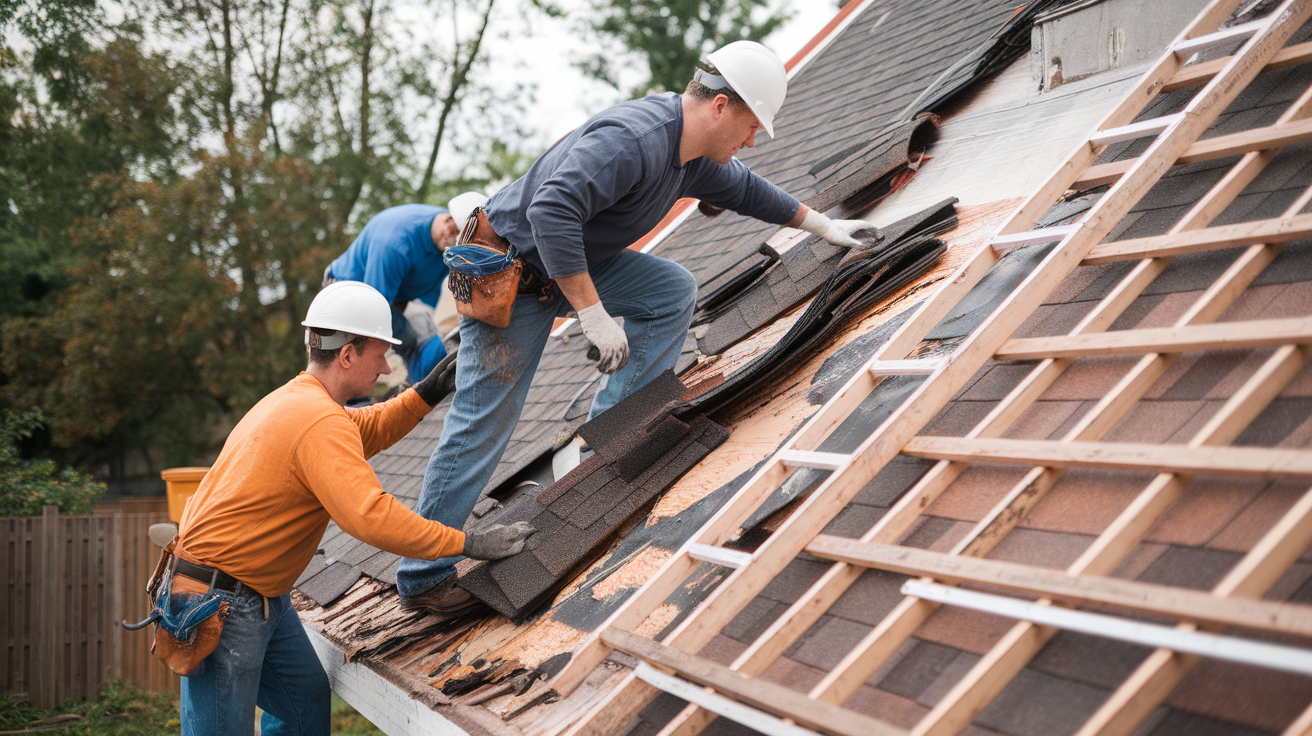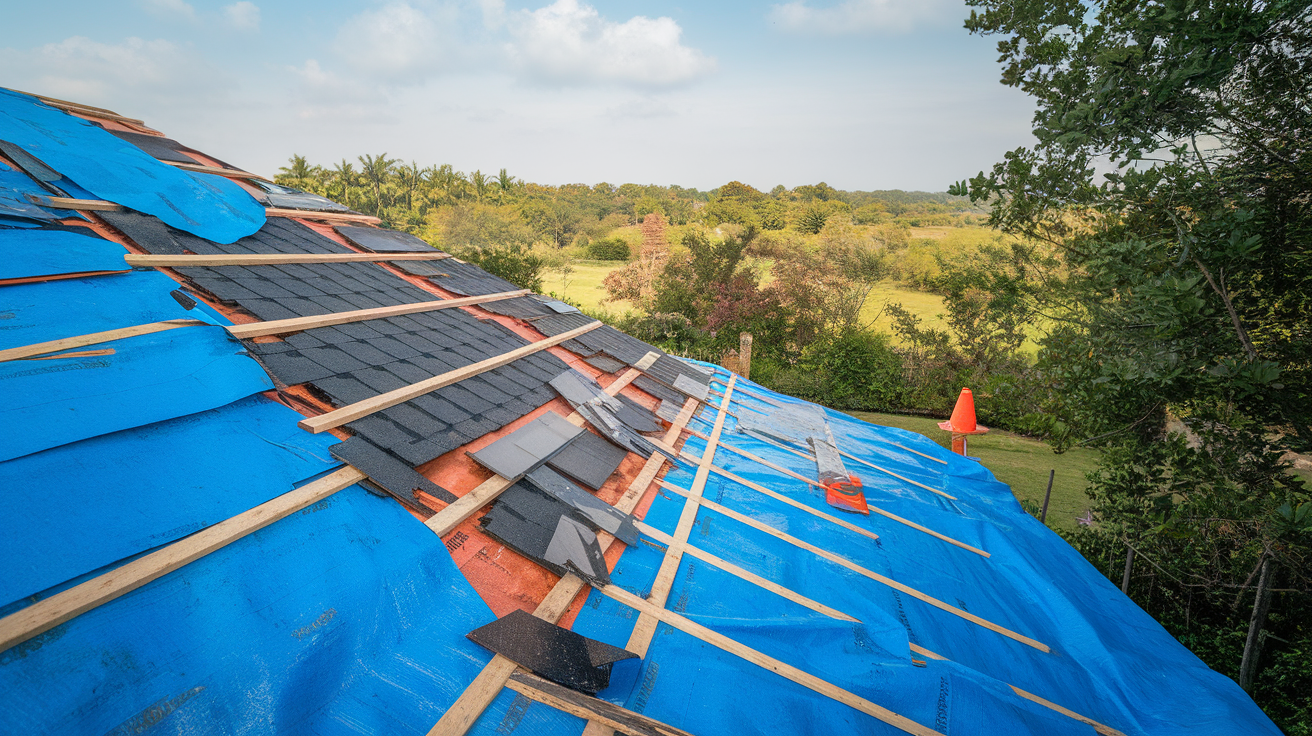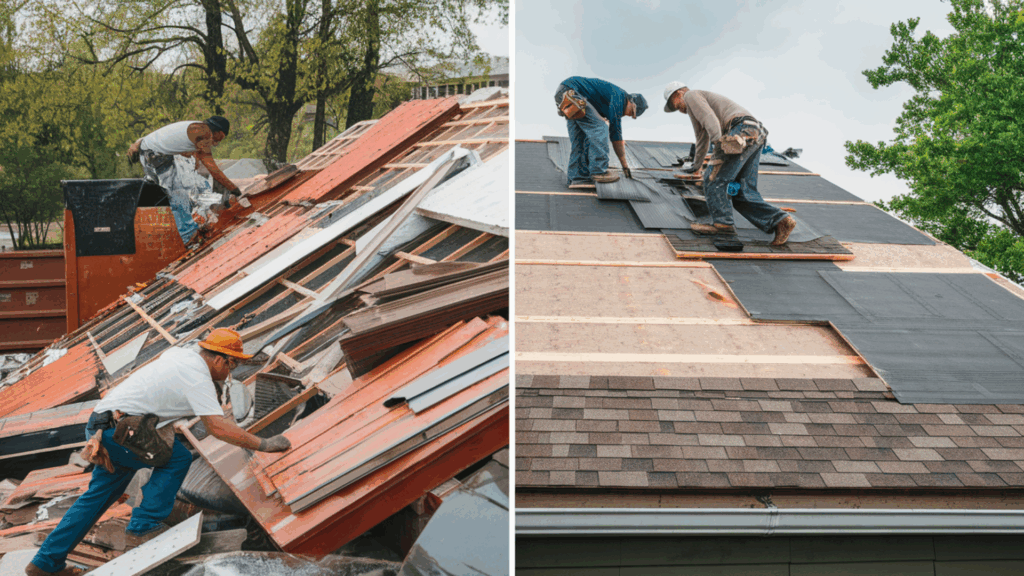Replacing a roof is a significant investment that I know can be both overwhelming and costly.
When I first faced the decision of whether to tear off my old roof or overlay new materials, I spent a lot of time considering the pros and cons of each approach.
From my experience, the decision truly depends on the condition of your existing roof, your budget, and how long you plan to stay in your home.
A roof tear-off involves removing the old roofing materials down to the deck, while overlaying allows you to install new materials over the existing roof.
In my case, after a careful evaluation, I opted for a tear-off due to the age and condition of my roof.
This blog will guide you through both options, allowing you to make an informed decision, just as I did when I tackled my roofing project.
What is a Roof Tear-Off?

A roof tear-off involves completely removing the old roofing materials down to the roof deck, allowing for a fresh installation of new roofing materials.
This method enables a thorough inspection of the underlying deck for hidden issues, including rot, mold, or structural damage.
It provides a solid foundation for the new roof, making it the preferred method when durability and long-term performance are priorities.
Pros of Roof Tear-Off
A roof tear-off involves removing the old roofing material completely before installing new layers. This method offers several advantages, ensuring better long-term performance and durability.
1. Comprehensive Inspection
A roof tear-off provides a full opportunity to inspect the roof deck. Hidden issues, such as rot, mold, or damage, can be identified and addressed before installing new materials, thereby preventing potential future problems.
Additionally, when you tear off the old roof, it allows the contractor to inspect flashing, vents, and valleys, which are critical parts of a roofing system that can sometimes be overlooked in an overlay job.
Any issues found can be addressed, preventing potential leaks and other problems in the future.
2. Longer Lifespan
Tearing off the old roof provides a clean, solid foundation for the new materials, which helps extend their lifespan.
Without the underlying moisture or damage that might be present in an overlay, new roofing materials can perform more effectively, offering better protection against the elements.
This ensures that your new roof will last longer, reducing the likelihood of future repairs and improving the overall strength of your home’s roofing system.
3. Improved Ventilation and Insulation
Removing the old roof allows for improved ventilation. If your attic or roof has poor airflow, a tear-off provides an opportunity to install a proper ventilation system, which reduces moisture buildup and improves energy efficiency.
Additionally, it’s easier to improve insulation during a tear-off, as the old roof deck is removed, giving you access to the attic space.
Adding or replacing insulation will help lower heating and cooling costs.
4. Increased Home Value
A roof tear-off can significantly increase your home’s value by providing a new, solid roof. Buyers tend to appreciate a properly installed roof, making it a strong selling point.
With a new roof in place, you’re likely to receive higher offers and experience a quicker sale, as it reassures potential buyers that they won’t need to worry about costly roof repairs in the near future.
Cons of Roof Tear-Off
While a roof tear-off offers many benefits, it also comes with some drawbacks. It can be more expensive and time-consuming compared to overlaying new materials.
1. Higher Initial Costs
Tearing off an old roof comes with higher upfront costs, as it requires payment for labor, materials, and the removal of debris.
This can add up quickly, making it a more expensive option compared to overlaying. If you’re working with a tight budget, the additional costs may be a key factor in deciding whether to proceed with a roof tear-off.
2. More Time-Consuming
A complete tear-off takes more time because of the removal and inspection processes. The project can be disruptive, lasting several days, depending on the roof’s size and any underlying issues that are discovered.
If problems such as damage or mold are found, the timeline may be extended, causing additional delays and disruptions during the roof replacement.
3. Labor and Material Costs Can Add Up
A tear-off requires more labor and may involve additional material, such as decking, which can cause the overall cost to increase quickly.
The need for extra supplies, along with the extended work hours, makes this option more costly than overlaying. If you’re on a tight budget, these additional expenses should be carefully considered before proceeding with a tear-off.
What Is Roof Overlaying?

Roof overlaying is the process of adding a new layer of roofing materials directly over an existing roof, without the need to remove the old roofing.
This method can be a more affordable and faster alternative to a full tear-off, as it eliminates the labor and disposal costs of removing the old roof.
However, it’s important to ensure the current roof is in good condition, as underlying issues like leaks, rot, or damage may remain hidden.
Roof overlaying can be a good option for homeowners looking for a quick fix, but it may not offer the same long-term durability as a complete tear-off and replacement.
Pros of Roof Overlaying
Roof overlaying is a quicker, more affordable solution than a tear-off. It saves time and disposal costs by skipping the removal of the old roof. If the existing deck is in good condition, overlaying avoids deck replacement, making it a budget-friendly option
1. Cost-Effective
Overlaying is a more affordable option because it eliminates the need to remove the old roof and dispose of the materials.
This dramatically reduces labor and disposal fees. The only costs you’ll incur are for the new roofing materials and installation, making it a quicker, more budget-friendly solution compared to a complete tear-off.
It’s a practical choice if you’re looking to save money without completely replacing the roof structure.
2. Faster Installation
Since overlaying skips the removal process, installation is faster. The new roof can often be completed in just a few days, making it a quicker solution for those needing a roof replacement right away.
Additionally, because the process is quicker, you won’t have to deal with the mess and disruption of tearing off old materials, which can be especially helpful for homeowners with busy schedules or who need the work done on time.
3. Minimal Disruption
With overlaying, there’s less mess, noise, and disruption to your daily routine. Since the roofing crew doesn’t have to remove the old layers, the process is quieter and cleaner.
This results in a less invasive experience for homeowners, as there’s no need to deal with the debris or lengthy delays associated with a complete tear-off.
Overlaying is a more practical option, especially for those with busy schedules.
4. No Need Decking
If your current roof deck is in good condition, overlaying removes the need for expensive deck replacement, saving both time and money.
This makes overlaying a more affordable and efficient option, as it focuses solely on adding a new layer of roofing materials without the added costs and labor of replacing the underlying structure.
It’s a great choice if your existing deck is still solid and intact.
Cons of Roof Overlaying
Roof overlaying is quicker and cheaper, but has downsides. Hidden issues like rot or leaks may remain, and added weight can cause structural problems. It also doesn’t fix ventilation or insulation issues.
1. Shorter Lifespan for the New Roof
Overlaying doesn’t address any hidden damage beneath the old roof, such as rot or mold, which can cause the new roof to deteriorate more quickly.
The added layer may not be as sturdy as a roof installed on a fresh deck, potentially reducing its lifespan.
This can result in the need for more frequent repairs and may compromise the overall performance of your new roofing system over time.
2. Increased Roof Weight
Adding an extra layer of roofing materials increases the overall weight of your roof. If your home’s structure isn’t built to handle the additional load, it could lead to structural issues over time.
This added weight may cause stress on the roof deck or the supporting framework, potentially leading to sagging or even more serious damage if not adequately accounted for during the overlay process.
3. Hidden Damage
Adding an extra layer of roofing materials increases the overall weight of your roof. If your home’s structure isn’t built to handle the additional load, it could lead to structural issues over time.
This added weight may cause stress on the roof deck or the supporting framework, potentially leading to sagging or even more significant damage if not adequately accounted for during the overlay process.
4. Poor Ventilation and Insulation
An overlay doesn’t fix existing ventilation or insulation problems. If your roof already has poor airflow, adding a new layer can worsen the issue by trapping heat and moisture beneath the surface.
This can lead to increased humidity, potential mold growth, and reduced energy efficiency.
Without addressing these underlying issues, the new roof may not function optimally, thereby shortening its lifespan and potentially creating additional problems over time.
Which Option Is Right for You?
Choosing between a tear-off and overlay depends on several factors, including your budget, the condition of your roof, and the urgency of the job.
- Budget: If cost is a primary concern, overlaying is a more cost-effective option. However, if you want a roof that lasts longer and requires less maintenance, a tear-off may be a better investment.
- Roof Condition: If your roof is showing signs of damage, a tear-off is the best choice to fix underlying issues. If the roof is still in good condition, overlaying may be sufficient.
- Timeframe: If you need a fast solution, overlaying will complete the task more quickly. However, if you want a thorough, long-term solution, a tear-off will provide a more complete result.
Conclusion
From personal experience, I can tell you that choosing between a tear-off and overlaying depends on both the immediate costs and the long-term benefits.
When I replaced my roof, I opted for a tear-off because my roof had some hidden issues that I wanted to address for the sake of durability.
While it was a bigger investment upfront, I found peace of mind knowing that my new roof was built on a solid foundation.
Overlaying is an excellent option for those with limited budgets or for homes with roofs in good condition. However, it doesn’t address underlying issues and might not last as long.
By considering your roof’s current condition, your budget, and the length of time you plan to stay in your home, you can make the best choice for your situation.
Don’t hesitate to consult with a professional roofer to help guide you through the decision-making process.

